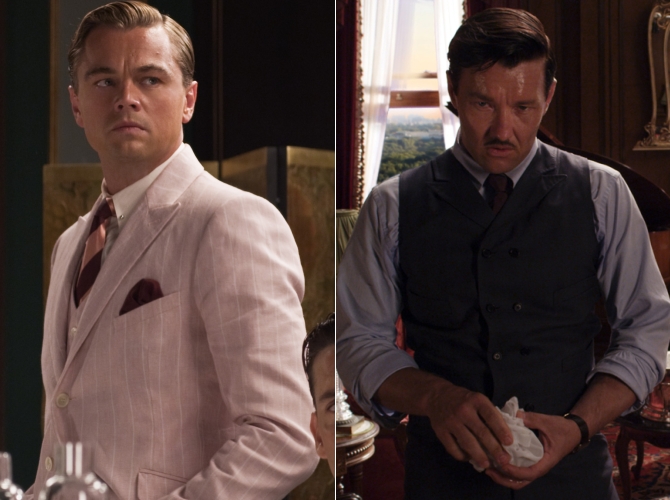The Great Gatsby's Fabulous Betrayal of 1920s Fashion
The details of the new film's wardrobe aren't historically accurate, but its costumes successfully convey the glamour and decadence of the era for a 21st-century audience.

Feathered headpieces? Check. Long strings of beads? Check. More Brooks Brothers than a Princeton reunion? Check. Spectator shoes, cloche hats, and Bakelite bangles? Check, check, check. The Great Gatsby delivers the fashion clichés of the 1920s (and a few from other eras) that we expected to see.
But they don't look quite as we expected to see them. The colors are richer, the dresses more bespangled, and the flappers less perky. This Gatsby isn't the Gatsby of John Held, Jr. cartoons, nor is it Boardwalk Empire. It's darker, grittier, and much sexier than the priggish Fitzgerald could have imagined. It's a 21st century Gatsby, set in the 1920s, which, paradoxically, ups its connection to the decadent period it depicts. If you want historically accurate costumes, you'll be better served by PBS. If you want to understand the social and cultural meaning of clothes in the 1920s, then this movie delivers.
Self-appointed protectors of the novel and your "history buff" neighbor will swear Luhrmann gets it wrong, but there is no "wrong" in an interpretation, old sport. And I know that Luhrmann's camp cared about the historical details, because as an academic who writes about Fitzgerald-era fashion, I sat in a room with production designer Catherine Martin. She asked me pointed questions about period clothing. "Would Gatsby's tie have been this fabric or this fabric?" she said, pushing swatches across the table. "That one, because it's a natural fiber. There were no synthetics until the 1940s." Understanding the history and then choosing when and where to use it is different than simply ignoring it. It is far more important that Luhrmann gets the cultural context of the clothing. And he does.
In the movie, as in life, socioeconomic class defines a character's dress. In 1920s New York, class was beginning to change. Old money and Tom Buchanan-types were losing their hold on American culture. Gatsby and his parvenus pushed the boundaries of "appropriate." Bye-bye tailcoats. Hello tuxedos. In the extravagant party scenes, Luhrmann mixes the old guard with the new—a Western senator in a 10-gallon hat dances with a debutante; Ivy League boys wear white flannel pants and feel up film stars. Things are not trickling down anymore, Dr. Veblen. Fashions flourish in the strangest of places.
Luhrmann's Tom wears a fitted, dark blue, double-breasted vest and suit coat. He is restrained. Gatsby sports that pink linen suit—a detail modern readers remember because of its connotations with gender. In its cultural context, however, the color was about class and about showiness. The pink suit—pinstriped and paired with a burgundy tie and gold collar bar—reveals Gatsby's true beginnings. Tom and Nick adhere to the kind of sartorial understatement their mummy taught them and they cultivated on green quads. The contrast between the blueblood and the bootlegger is striking, and moviegoers would get it without the multiple mentions of the suit by Buchanan. If audiences literally want to get it, they can hightail it to Brooks Brothers. The firm, who dressed the author and his Princeton pals, has rolled out a Gatsby-inspired collection, complete with tapered pant legs a la Don Draper—certainly not 1922, but saleable nonetheless.

The women's costumes are more nuanced, but just as significant to Luhrmann's character development. Even those details that are clearly not 1920s (Myrtle Wilson's ridiculous 1950s' cleavage, for example) get the point across: Myrtle does the things in bed that your wife will not. Daisy Buchanan is bound to a dying social hierarchy and believes "the best thing a girl can be in this world, a beautiful little fool." True to the text, she wears lavender and lace. The fitted cut of her dresses is more 1912 than 1922.
But Jordan Baker is a professional athlete, a party girl. In the book, she lives with her maiden aunt—a social necessity for a woman of her background. Luhrmann's Jordan lives alone and, as a coupe pulls away from Gatsby's party, she yells for Nick to call her. Fitzgerald's Jordan wears sports clothes as a badge of her profession and her sensibilities. Luhrmann's Jordan is so progressive, she wears styles from the 1930s—a backless, floor-length evening gown, a capped sleeved blouse with a matching capelet, and pants. Yes, pants. These are not the pants worn as evening pajamas to beach resorts in the late 1920s. These are palazzo pants, much like the ones I wore to my cousin's wedding last summer. Historians need not haggle over their accuracy. The pants are out of place, but the message is on point. Daisy wears white cotton dresses. Jordan wears pants.

The major players aren't the only ones Luhrmann updates. When an Australian director interprets the social hierarchy of 1920s America, everybody gets to go to the party. Fitzgerald's audience was white, but Luhrmann's audience is not. Expect to see fleshy, black dancers, an Arab-looking Wolfsheim, and a few interracial couples. True to form, Luhrmann steps beyond the "ideal" body type—or even one so closely associated with the era (read as: knobby knees and twig-like arms). Thick-waisted women, short, stocky men, and some drag queens bring Luhrmann's interpretation into the 21st century.
The costumes of The Great Gatsby will not withstand the rigors of academic analysis, but who cares about "real" history, anyway? The film's costumes entice and inspire—boater hats, bejeweled headbands, fringed frocks, and all. Just as Gatsby's lavish lawn party aimed to lure Daisy across the bay, Luhrmann lures a modern audience to listen once again to a story they've heard before.
Aisling O'Connor contributed research to this article.